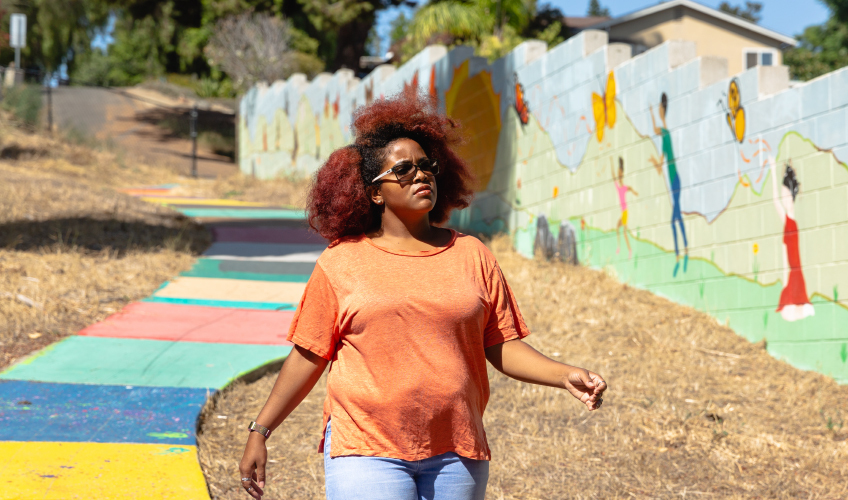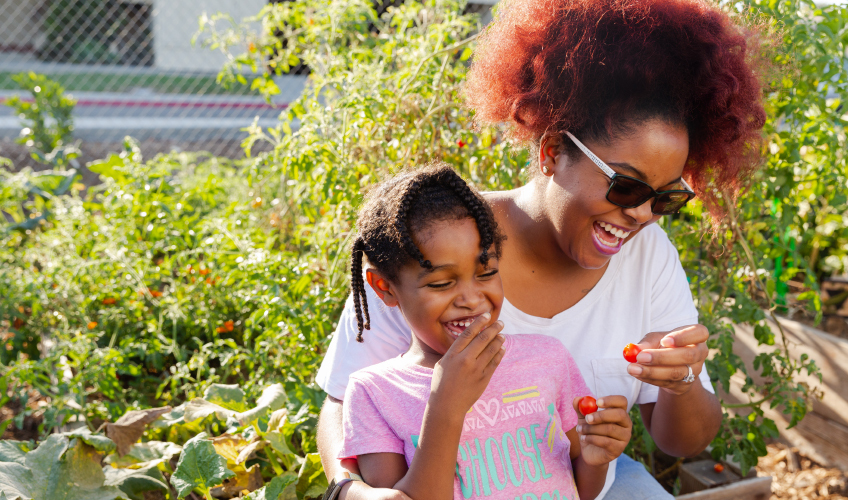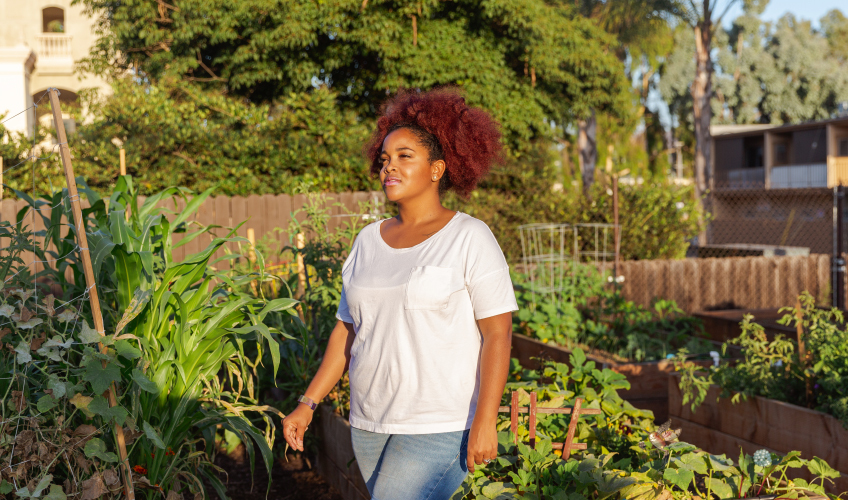Links to various Aetna Better Health and non-Aetna Better Health sites are provided for your convenience. Aetna Better Health is not responsible or liable for non-Aetna Better Health content accuracy or privacy practices of linked sites or for products or services described on these sites.
How living in food insecurity changed this mom’s perspective
 By Mark Pabst
By Mark Pabst
My name is Shanae. I’ve always lived in Southeast San Diego.
Lemon Grove is a small city within San Diego.
We only have a couple of shopping centers that has produce.
Back when I was younger, I think I wouldn't even knew what to do with fresh produce if I had it in front of me or where to get it from.
I basically was on my own at 17 because my mom moved to Virginia at the time.
Kids my age still lived at home with their parents… So everything was there for them. Me, I had to figure out everything and it was rough.
Back in the day if I woulda walked into a local store with $10, I woulda walked out with a whole bunch of junk food.
Buying junk food stretched my dollar so much because I could get a whole meal in a ramen.
I wasn't thinking about my health. I'm young… I wasn't planning for the future.
I ended up getting pregnant at 19 and that's when everything just shifted even further to being harder.
(STAT: 1 in 9 Americans is food insecure Source: USDA)
I wasn't able to get any kind of health insurance before I had my child. I wasn't qualified for food stamps either.
I was hungry, honestly.
I had to distract myself because if I ate something now, I knew I wouldn't have anything for lunch or dinner.
I think things are better for me now is because I got knowledge from my midwife.
She said I needed to eat more fruits and vegetables.
So I joined WIC. She was able to help me with getting more food stamps.
So much has changed in the time of being a single mother. Now I'm married, have three beautiful kids.
Food is better accessible to me now because my Lemon Grove community garden and also my Lemon Grove farmer's market.
My kids are more likely to eat produce from the farmer's market and the community garden than they would from the produce store. It tastes better and they're healthier. We know where they come from.
(STAT: With Aetna’s support, more than 1.6 million Americans now have access to healthy food within a mile of their home Source: Aetna Foundation)
Now with having more access to fruits and vegetables that are organic, I try a range of different recipes.
Having access to the community garden and the farmers market, the fresh foods that they sell is worth wonders.
Not just for my family but also for the community.
On most afternoons, you can find Shanae in her sunny Lemon Grove, CA, kitchen, whipping up a meal for her husband and three children. She loves creating new recipes and is always experimenting with ways to use fresh ingredients and exotic vegetables.
But cooking wasn’t always so enjoyable for her. For two long years, she struggled to feed herself. Though it’s been nearly a decade since she went hungry, Shanae still remembers that time like it was yesterday.
Her experience began when she was just 17. Her mother decided to move to Virginia, and Shanae opted to stay in Lemon Grove to attend community college. She had a full load of classes, a part-time job and — for the first time ever — a host of bills to pay every month. “I had to manage all my necessities, like gas, car insurance and rent, on less than $1,000 a month,” she says. “It was hard. I really had to stretch my food budget.”

After her mother moved out of state, Shanae had to support herself. She was only 17.
Oftentimes, that meant allowing herself $50 a month for groceries. The paltry amount was usually enough for cheap, processed foods like instant noodles and canned goods. On days when her food supply was low, she’d skip meals, drink water to stave off hunger pangs or get by on sheer willpower. “Sometimes when I got hungry, I’d try to distract myself and think about things I had to do for school, or stuff like that,” she recalls.
Though she didn’t know it at the time, Shanae was far from alone. In the United States, approximately 40 million people live in food insecurity. San Diego County, where Lemon Grove is located, has more than 360,000 food-insecure residents.
Unfortunately, for various reasons, many food-insecure residents are unable to get the assistance they need. In some cases, people don’t know help is available. Other times, people may not qualify for benefits or lack the documentation necessary to prove their need. That’s what happened to Shanae, who applied for government food assistance when she was 18 but was told she didn’t qualify. At the time she was disappointed, but looking back on it, she believes it was an error.
Though Shanae couldn’t take advantage of food assistance benefits then, she would occasionally get a helping hand from strangers. She remembers one grocery store run, when she realized she couldn’t afford everything in her basket. “I’m looking at the checkout clerk, and he’s looking at me like, ‘You’d better put some stuff back.’ I felt like time slowed down,” she says. “Then this gentleman standing behind me in line said, ‘Don’t put that back. I’ll pay for it.’ That saved me that month.”
Discovering a passion for healthy eating
Shanae’s luck turned when she was 19 and unexpectedly became pregnant. At first, pregnancy made her struggles with food even more difficult, as she tried to find healthy options that would fit within her budget.
But then, during a prenatal care visit at a local women’s health clinic, a midwife told her about the various benefits available to her. She helped Shanae sign up for benefits including WIC and Medicaid, which provided the mom-to-be with food and resources to get on the path to healthy living.
In addition, the midwife encouraged Shanae to eat more fresh fruits and vegetables. It wasn’t long before she became hooked on produce. Coincidentally, a farmer’s market sprung up in Lemon Grove around this time. It accepted food benefit vouchers and sold a wide variety of options at affordable prices. “I remember I used to go to the grocery store with $10 and come out with stuff like ramen, because that’s what I could afford,” Shanae says. “But for $10 at the farmers’ market, I could get big bunches of collard greens and apples and tomatoes. I got more food, and it tasted better.”
Giving back to the community
It’s been nearly a decade since Shanae struggled to feed herself, but the healthy habits she formed all those years ago continue today. She still frequents the farmers’ market, often with her husband and three kids in tow. The family has also started growing some of their favorite items, like tomatoes and greens, in the new Lemon Grove Community Garden, which is a five-minute drive from their home.

Shanae says her kids are more likely to eat produce from the farmers’ market and community garden than the grocery store. “It tastes better to them,” she explains.
Thanks in large part to those two outlets, Shanae and her Lemon Grove neighbors finally have access to fresh, affordable food. “Community gardens like the one in Lemon Grove are a powerful source of locally grown, seasonal produce,” says Jill Webber, MPH, cultural and health equity director and health educator for Aetna Better Health of California. But the benefits don’t stop there. “These gardens are also a powerful source of health benefits like stress reduction, physical activity and human connection,” she explains. “In fact, these gardens are so important to a person’s overall well-being that we’re exploring ways to provide our members with no-cost transportation to their local gardens.”
Of course, access to a garden is only good if you’re eating what you’re growing. To help her neighbors figure out how to take full advantage of the bounty now at their fingertips, Shanae has created healthy recipes that feature locally grown ingredients. She shares them online and with her fellow gardeners.
She also tinkers with recipes in the cookbook provided by the WIC program. Shanae remembers how bland the dishes tasted back then, so she created modified versions that are packed with flavor. She posts the recipes on social media in the hopes that they inspire other people to embrace nutritious food.
“Now, with Lemon Grove having more access to fruits and vegetables that are organic, we’re in a place where we can try a range of different recipes,” she explains. “I share these recipes because I know they can help other families eat healthy, try new things and also feel empowered when they're cooking at home.”
Though her days of food insecurity are firmly in the past, Shanae says the experience has made her grateful for all the fresh, healthy and affordable choices that are now available in the neighborhood. She wants others who struggle with food insecurity to know about these choices as well. “I feel like I have more options for healthy foods, and that makes it so much easier to afford the kinds of food that I know are good for me and my family,” she says. “I think everybody should have these options.”

Aetna is the brand name used for products and services provided by Aetna Better Health and/or its affiliates.
About the author
Mark Pabst has worked as a writer and researcher in the health care field for almost two decades. When not writing about health he tries to stay healthy through activities like hiking, climbing and paddling in the far flung corners of his native state of California. However, despite his best efforts he still has a few unhealthy habits he can’t shake, most notably a weakness for jelly donuts.

